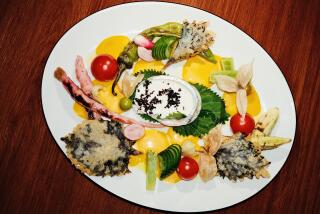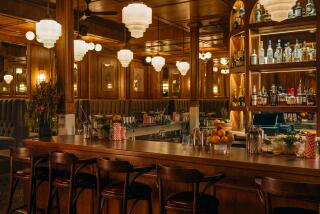Rhone kicks up its heels
Paso Robles — It’s safe to say that the Hospice du Rhone is the only major wine festival in the world that kicks off with a bowling tournament. And the bowling -- between glasses of Cote Rotie, Pic St. Loup and Aussie old-vine Grenache, or local Syrahs and Grenache roses (or bottles of Corona and the occasional shots of Hornitos) -- is extremely competitive. Participating wineries routinely bring in hotshot bowlers to work harvest just so they can gain an upper hand at the tournament the following spring. The bowling trophy is as coveted as it is garish (the winning team gets to add its own touches to the existing pastiche); two years ago it was kidnapped and retooled with beer-top pasties on its bowling-pin bust line. The culprits were never found, but certain French producers not known for their bowling skills are the prime suspects.
In an industry that takes itself far too seriously, Hospice du Rhone is a Central Coast antidote. The event, which ended Saturday, is an annual homage to the wines and the laid-back vibe of Rhone varieties.
For the record:
12:00 a.m. May 25, 2005 For The Record
Los Angeles Times Tuesday May 24, 2005 Home Edition Main News Part A Page 2 National Desk 0 inches; 27 words Type of Material: Correction
Vineyard -- An article about a wine festival in Paso Robles in Wednesday’s Food section said John Alban finished planting his vineyard in 1989. It was 1986.
For The Record
Los Angeles Times Wednesday May 25, 2005 Home Edition Food Part F Page 3 Features Desk 0 inches; 30 words Type of Material: Correction
Vineyard -- An article about a wine festival in Paso Robles in last week’s section said that John Alban finished planting his vineyard in 1989. The correct year is 1986.
Each spring, producers from France, Italy, Spain, South Africa, Australia and the States gather in Paso Robles for a weekend of unabashed, geeky conviviality, inspired perhaps by the wines themselves, many of which are known for their approachability. “Rhone wines are not stuck-up,” says Gigondas producer Louis Barruol of St. Cosme. “They are friendly; in the glass they come to you and jump on your nose.”
In full possession of nose-jumping friendliness, Hospice du Rhone has officially hit its stride. This year more than 2,500 people attended to taste the wares of more than 200 producers with well over a thousand wines on hand, all made from Rhone varieties. Thirteen years ago, when the event got its start, most of these varieties were completely unknown in this country. “We think it’s reached a point,” says John Alban of Alban Vineyards, one of the event’s founders, “where you can’t separate Hospice du Rhone from the Rhone movement in this country.”
It might be a movement now, but even in France, Rhone variety wines had long been obscure, neglected and often ignored, and marketing them to the wine-drinking world was an uphill battle. Vines have been planted in the southeastern region of the country since Roman times, but Rhone has never been the sort of place where the varieties were limited to a well-known few, as in Burgundy or Bordeaux. Indeed, more than 20 are produced here; the most famous is Syrah, but there are plenty of obscurities in the ground as well, with names like Bourboulenc, Ugni Blanc and Picpoul. Even its most celebrated white, Viognier, possesses the sort of French name that most Americans won’t even dare to pronounce (it’s vee-own-yay). And Condrieu (con-dree-ew), the Northern Rhone appellation where that grape often achieves its best expression, isn’t any easier.
But that is the wine with which both Alban and his founding partner Mat Garretson had their respective wine epiphanies. Alban was in California at the time finishing up a winemaking degree at UC Davis; Garretson was working at a wine shop in Gainesville, Ga. In Alban’s case, he was so overcome that he moved to Condrieu to work with anyone who would take him, and stayed for four harvests. He returned with vine cuttings, and when in 1989 he finished planting his vineyard, a 32-acre block in the Edna Valley, he had doubled the acreage for Viognier in the world.
Garretson, meanwhile, had founded a rather vague promotional entity called the Viognier Guild. When Alban learned about it, he says, “I told him that that is positively the most preposterous thing I think I’ve heard all year, and can I be member No. 1? I was taken in by him because I knew he had no hope for success.” Garretson threw his first event in Georgia in 1993. “There were 35 wines and 20 people,” says Garretson, but one of those present was Alban, who convinced Garretson that any subsequent celebrations should take place in California, where he might find a more like-minded crowd. Garretson, who since has started a winery bearing his name, moved out west, and settled on Paso Robles as the venue.
Fanatics welcome
Trying to persuade winemakers from, say, Barossa or Hermitage to come to a cow town in Central California and pour their Reserve and Library wines -- oh, and bring your bowling shoes -- was an endeavor that met with a fair amount of derision. But, says Alban, hardship was part of the point. “It’s not convenient to come here,” he says. “You’ve really got to be dedicated. We insist upon fanaticism, but hopefully we make it worth your while.”
Hospice derives its name from Hospice du Beaune, the famous wine festival and lavish benefit auction in Burgundy, and like its namesake, Hospice du Rhone has an auction, albeit tiny and possibly more manic. Like other festival events, it is held at Paso Robles’ California Mid-State Fairgrounds, a locale that might as well be the anti-Meadowood (the manicured setting for the Napa wine auction). Hospice seminars are held in cavernous corrugated fairgrounds warehouses that serve as horse paddocks and roller rinks in other months. Meals are served family-style on picnic tables lined by a mock Western town square that carries endorsements from Food 4 Less and Budweiser.
But people don’t spend a lot of time dwelling on their surroundings. At one of four morning seminars, you can sample verticals and vineyard designates from the finest, hottest, most cutting-edge producers of Rhone varieties in the world. Michel Chapoutier has made several visits here, as have Chateau de Beaucastel’s Francois Perrin and Chateau la Nerthe’s Alain Dugas, both from Chateauneuf-du-Pape, as well as emergent stars from the region such as Yves Cuilleron, Francois Villard, and Yves Gangloff.
From Australia, Dave Powell of Torbreck has led vertical tastings of old vine Grenaches and Shirazes. So has Chester Osborne of d’Arenberg, and Ron Laughton of Jasper Hill. And of course, many of the local winemakers who have spearheaded the Rhone movement in California are on hand, including Alban, Qupe’s Bob Lindquist, Andrew Murray and Steve Edmunds of Edmunds St. John. Much attention is paid to the minutiae of growing and winemaking -- yields, clones, trellising, and so on -- so you can get your geek on if you want to. But it’s really about what’s in the glass. This year the great Spanish producer Alvaro Palacios was on hand to taste through nine of his old vine Priorat bottlings -- an unforgettable way to spend a Saturday morning.
Alban and Garretson are winemakers, not event coordinators, and Hospice du Rhone has seen years of epic disorganization. There were late lunches, lost wines, long lines, nonexistent service, ugly T-shirts, ice shortages, extremes of heat and cold and many other snafus. For years, it seemed that they’d have to commit every logistical mistake at least once in order for it not to be repeated.
Perhaps the worst occurred in 1997, their first year at the fairgrounds, when Alban and Garretson stood in a room where there had been a tasting gazing on rows of tables filled with thousands of dirty glasses. “And I said to Mat,” says Alban, “ ‘So which part of the fairgrounds has the dishwasher?’ ”
Of course there was none, and the glasses had to be reused the next morning. So they called all of their friends who had restaurants in town and asked if they could come in and use their dishwashers.
“Then,” says Alban, “we got out a calculator, counted the glasses and concluded that if we worked through the night, we might be done by 6 a.m.”
In 2000, Vicki Carroll, the former director of the Edna Valley Vintner’s Assn., came on board. With a network of volunteers and the know-how to ward off disasters, she’s managed to apply a bit of polish on what will always be a fairly scruffy affair. And so while it still feels a bit seat-of-the-pants, it’s smoothly run. Packages and tickets to next year’s Hospice events, which include tastings and seminars, will be available to the public through www.hospicedurhone.com, (805) 784-9543.
“Hospice du Rhone is the ultimate illustration of that idea that anything worth doing is worth doing poorly,” says Alban. “The idea of championing these wines with an event was so worthwhile, that even though we were thoroughly inept at its execution, it was bound to succeed.”
*
(BEGIN TEXT OF INFOBOX)
The buzz of the festival
The new and upcoming releases that created the most excitement at the Hospice du Rhone last weekend in Paso Robles:
2003 Qupe Bien Nacido Vineyard Hillside Estate Roussanne. An ethereal new release from young vines on Bien Nacido’s hilltop plantings. Will be available in mid-June at Duke of Bourbon in Canoga Park, Wally’s Wine and Spirits in West L.A. and Hi-Time Wine Cellars in Costa Mesa, about $40; www.qupe.com.
2003 Core Blend 442. A spicy blend of Mourvedre, Grenache and Syrah from a high-elevation vineyard in Santa Barbara County. Available June 1 at the Cheesestore of Silverlake, the Cheese Store of Beverly Hills and Wine House in West L.A., about $26; www.corewine.com.
2003 Big Basin Vineyards Rattlesnake Rock Syrah. Smoky, bracing, cool weather Syrah from the Santa Cruz Mountains. Available in November at Twenty Twenty Wine Merchants in West L.A. and Wade’s Wines in Westlake Village, about $48; www.bigbasinvineyards.com.
2003 Pax Wine Cellars Alder Springs “The Terraces” Syrah. A brooding, meaty, tightly wound Syrah from Mendocino County, with aromas of violets and leather. Available only through the winery, about $75 (707) 591-0782; www.paxwines.com.
More to Read
Eat your way across L.A.
Get our weekly Tasting Notes newsletter for reviews, news and more.
You may occasionally receive promotional content from the Los Angeles Times.










